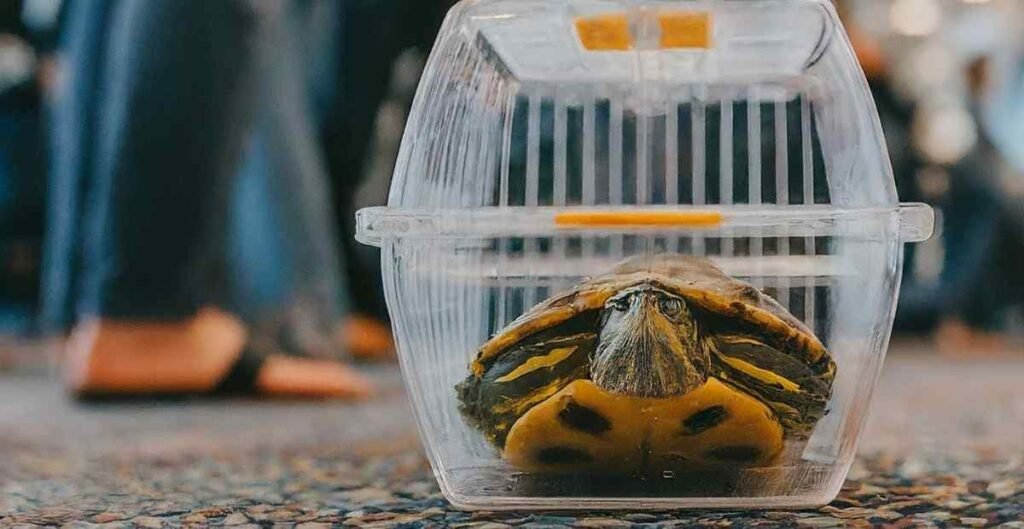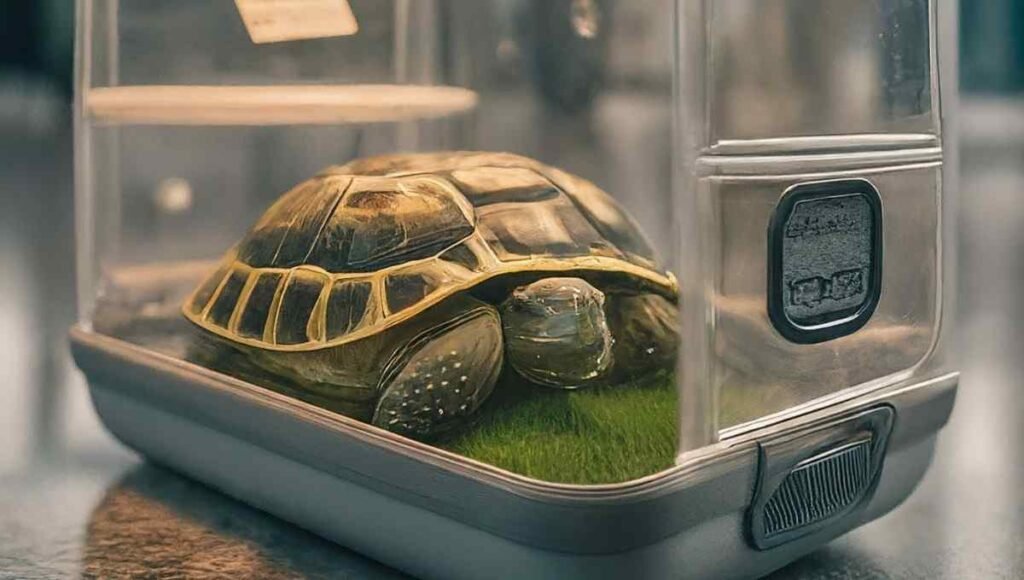Pet turtles are becoming more popular day by day. If you are a pet turtle owner and decide on your next vacation trip, the first query will be about your pet: Can turtles fly with you? You will also have this question: can you leave it behind? But here we will talk about the first option: can turtles fly? With this question, there can be another confusing query: turtle flying ability. The truth is turtles’ bodies are designed for swimming and walking, not for flight.
However, when we talk about “flying turtles,” we mean – is a turtle pet owner allowed to fly with their pet? This answer depends on some criteria; sometimes, you can fly with your pet turtle, and sometimes, you can’t. In today’s post, we will discuss in detail whether turtles can fly with you or can’t.
Can Turtles Fly on Plane?

Yes, turtles can fly, but only if the airline company and your country’s airport rules and regulations allow it. Not everywhere, you can fly with your pet turtle. So, when considering this, you have to do a little research. The good thing is we have covered most of the specifics of this query.
Another case can come – let’s assume a bulk of turtles need to be imported from one region. It can be for research purposes, conservation or keeping them in a zoo. For this, there will be some specialized container-supported arrangements on some airplanes.
What Should You Know About Airline Policies for Flying with Turtles?
First, you must look for the airline policy information to confirm if they allow pets like turtles to fly. If your region’s airline policies and certain airline companies don’t allow turtles, then it’s a red flag to have a flight with your pet.
Traveling with turtles involves careful planning, especially when recognizing airline policies. We have made a guide to help you navigate these policies effectively.
How Airline Policies Can Vary
Airline policies for traveling with turtles can differ greatly. Some airlines may allow turtles in the cabin, while others only permit them as cargo. Certain airlines, like American and Delta, do not allow turtles in the cabin at all, only cargo. It’s crucial to verify the specific requirements of your chosen airline.
Researching Airline-Specific Regulations
Research the airline’s regulations well ahead of your trip to ensure a smooth journey. Here are some methods:
- Visit Airline Websites: Check the pet travel sections for the latest information on regulations and requirements.
- Contact Customer Service: Directly call airline representatives to clarify doubts or obtain specific details.
- Read Online Forums: Platforms like Turtle Forum can provide insights from others who have traveled with turtles.
Key Components to Check
When planning to fly with your turtle, pay attention to these key aspects:
- Documentation: Airlines may require health certificates or proof of vaccination. Always check these requirements in advance.
- Carrier Specifications: Choose a carrier that meets airline standards. It should be sturdy, well-ventilated, and secure.
- Fees: Be aware of any extra fees for traveling with pets. These can vary between airlines, so confirm the details to avoid surprises.
Which Airline Companies Allow Turtle?

Several airlines allow pets like turtles to fly. Although there are specific restrictions, generally, turtles fall under the “non-dangerous animals” category and may be allowed in the cargo hold. However, each airline differs on whether they can be carried in the cabin. Here are some of the options that allow pet turtles:
- Air Europa: This company allows aquarium turtles and small pets like dogs and cats to be in the cabin.
- Delta Air Lines: This airline allows household birds, including some reptiles, to fly domestically in the U.S. However, they allow turtles as cargo, provided they meet carrier specifications.
- Air India: Turtles are allowed as checked baggage but cannot fly in the cabin on certain routes, especially through the Middle East.
- Frontier: Known for its pet-friendly policy, turtles may need to travel in cargo.
- WestJet: Permits turtles in the cabin if you provide proper documentation and fees.
These are not all the options. Before booking your flight, you have to look for more details from available airline companies, whether they allow pet turtles or not.
Some airlines only allow small cat or dog pets. Make sure you do your research in advance and prepare in advance to avoid last-minute hassles.
Turtle Travel Regulations – Federal and International
It is a unique adventure to travel with turtles; you have to look for regulations that must be adhered to carefully. Here’s what you should know more.
Federal and International Travel Regulations
Before traveling, it’s essential to understand the regulations for transporting turtles. In the United States, the CDC restricts the importation of certain turtles. For example, turtles with a shell length of less than four inches may not be imported for commercial purposes. Internationally, regulations can vary, so it’s a must to check the specific requirements of your destination country.
Required Documentation
When traveling with turtles, you must have the right documentation:
- Health Certificates: Many countries and states require a health certificate issued by a veterinarian within a specific time frame before travel.
- Vaccination Records: While turtles typically don’t require vaccinations, some regions might request documentation to ensure the animal is disease-free.
What Can Be Some Specific Restrictions?
Some countries or states have unique restrictions on turtle travel. For example, certain regions may have bans on specific species due to ecological concerns. Always research these details well in advance to avoid complications.
Practical Tips for Flying with Turtles
Ensuring a smooth journey for your turtle involves several practical steps:
Choosing the Right Carrier
Select a secure, well-ventilated carrier that meets airline specifications. Ensure it is comfortable and escape-proof. Sometimes, airlines may not allow your personal carrier, but you will be given the option to use theirs. In this case, you do not have much choice. Still, you can check out their option if they allow it.
Reducing Stress
Acclimate your turtle to the carrier before travel. However, if the carrier is from an airline company, there is nothing much you can do. But you have the option, and then you can do it. Check the essential setup for your turtle, such as enough water supply, food, the right temperature, etc. Keep the environment calm and quiet during the journey.
Monitoring Health
Try to check your turtle’s behavior and health throughout the trip. It is not practical enough if you are flying for a few hours. But if you are on the flight for long hours, then you can consider checking them if the authority allows.
Can Turtles Fly Physically?

Now, let’s look into the question of whether turtles can fly. This question also points to the turtle’s flying ability. Most people look for this information to know if turtles can fly on a plane or not. But let’s see: Can turtles fly physically or not? If not, why?
Anatomy and Limitations
Turtles are fascinating pets, but one thing is clear—they cannot fly. Their anatomy is specifically adapted for life on land and in water, not the skies. Turtles have heavy, protective shells made up of fused bones and ribs, forming a sturdy shield over their backs. This shell adds significant weight, which makes it physically impossible to fly. Additionally, turtles have short, sturdy limbs designed for walking and swimming, not for flapping like wings.
Why Turtles Can’t Fly Like Birds?
Unlike birds, which have hollow bones and powerful wings for flight, turtles are built for stability and protection. Their dense, solid bones and limb structure are not suited for taking off into the air. The design of a turtle’s body prioritizes defense and support, allowing them to thrive in their natural habitats but not to soar through the sky.
Misconceptions and Myths
There are many myths (most of them are from fictional characters) about turtles and their supposed ability to fly. Some tales might have stemmed from seeing turtles propelled through the air by external forces. For example, when a car drives over a turtle on the road, the impact can flip the turtle into the air. However, this is not flying—it is a rare and unfortunate result of an accident.
FAQs
Can turtles eat flies?
Yes, turtles can eat flies. Flies are a natural part of many turtles’ diets and offer essential protein. However, it’s important to ensure that any flies your turtle eats are clean and free from pesticides or harmful substances. Feeding flies occasionally can also stimulate their natural hunting instincts.
Can a turtle fly?
Turtles cannot fly in the traditional sense. They lack the physical structure, such as wings, necessary for flight. However, some species can swim adeptly underwater, using their limbs to glide almost like flying through water.
Can you fly with a turtle?
Flying with a turtle can be tricky as many airlines have specific reptile transport policies. Some airlines allow turtles in the cabin or as cargo, but checking with your airline beforehand is crucial. Ensure you have the necessary documentation and a suitable carrier for your turtle’s comfort and safety.
Can sea turtles fly?
Sea turtles can’t fly in the air, but their swimming style resembles flying. They use their large flippers to glide gracefully through the ocean, much like birds do in the sky. This unique movement is sometimes called “flying” through the water.
Can turtles fly in real life?
In real life, turtles cannot fly. They are not equipped with wings or the anatomy needed to take flight. While some turtles might perform impressive underwater maneuvers, they remain bound to the ground or water, using their limbs for locomotion rather than flight.
The Bottom Line
Traveling with your turtle can be simple with the right preparation. Remember to check all regulations, get the necessary paperwork, pick a comfy carrier, and keep an eye on your turtle’s health. With these steps in mind, you’re set for a smooth journey. Plan well, and enjoy the adventure with your turtle companion!
